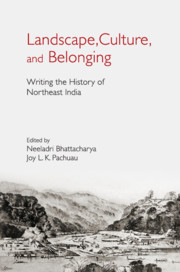Book contents
- Frontmatter
- Contents
- List of Figures
- Acknowledgements
- Introduction
- I Borders and Beyond
- II Surveys and Explorations
- III Ethnography, History, and the Politics of Representation
- IV Law, State, and Practices of Governance
- 8 Frontier Regime and Colonial Rule
- 9 The Law of Emptiness: Episodes from Lushai and Chin Hills (1890–98)
- 10 The Colonial State and the ‘Illegal’ Arms Trade along the North-East Frontier of India, 1860s to 1900s
- V Cultural Dialogues
- Notes on Contributors
- Index
9 - The Law of Emptiness: Episodes from Lushai and Chin Hills (1890–98)
from IV - Law, State, and Practices of Governance
Published online by Cambridge University Press: 26 April 2019
- Frontmatter
- Contents
- List of Figures
- Acknowledgements
- Introduction
- I Borders and Beyond
- II Surveys and Explorations
- III Ethnography, History, and the Politics of Representation
- IV Law, State, and Practices of Governance
- 8 Frontier Regime and Colonial Rule
- 9 The Law of Emptiness: Episodes from Lushai and Chin Hills (1890–98)
- 10 The Colonial State and the ‘Illegal’ Arms Trade along the North-East Frontier of India, 1860s to 1900s
- V Cultural Dialogues
- Notes on Contributors
- Index
Summary
Why are you jurists silent about which concerns you?
Introduction
In the first few years of the 1890s, after the definitive Chin-Lushai Expedition of 1890–91, the tract with Manipur in the east, Hill Tippera and Chittagong in the west, Arakan in the south, and Cachar in the north was parcelled between the Chief Commissionership of Assam and the Presidency of Bengal. There was a major conference held in Calcutta in the month of September 1892 where the Government of India pondered on the future administrative fate of this newly occupied tract. After much onerous deliberation, leading to a 500 page report among other things, no conclusive resolution was reached. The thrust of this jamboree was to do away with the tripartite division of governance of the Chin-Lushai Hills. It was, until then, divided between Assam, Bengal, and Burma. The North Lushai Hill district, with Aizawl as its base of operations, was left under the Chief Commissionership of Assam while the South Lushai district was administered from the Bengal Presidency. In 1885 Upper Burma had been incorporated into the British Empire. The problem of the Chin Hills was created with this ‘new’ acquisition.
My focus on this decade of 1890s is to amplify these indeterminate years: a decade marked by provisional governance arrangements. Eventually these stubs of districts were united within the Assam Chief Commissionership. Chin Hills remained outside as a ‘special division’ of British Burma. The time under consideration is suspended between the raids of the Lushais and the punitive British expedition. It is into this cleft that law worms in. The chapter follows this diligence and despair of law.
There are three sections to this chapter. I begin with the particular career of Bengal Regulation III of 1818 in the Lushai Hills in the late nineteenth century – how it apportioned and distributed ideas of political subjects and commensurate crimes that could be apprehended by this enactment, and the complications such extension of Bengal Regulation III up to the hills opened up.
In the second section I locate this travel of law, braided as it was with ideas of conquest.
- Type
- Chapter
- Information
- Landscape, Culture, and BelongingWriting the History of Northeast India, pp. 207 - 236Publisher: Cambridge University PressPrint publication year: 2019
- 1
- Cited by

